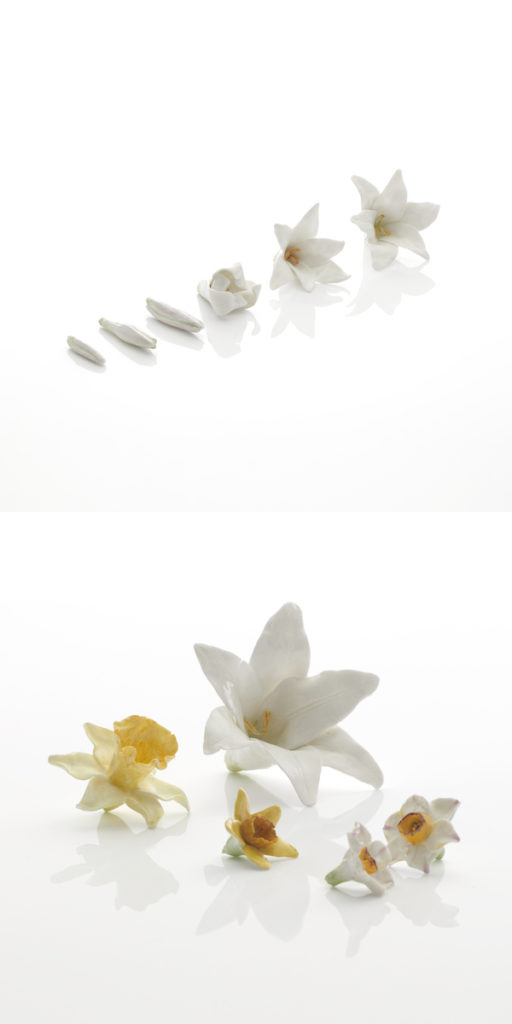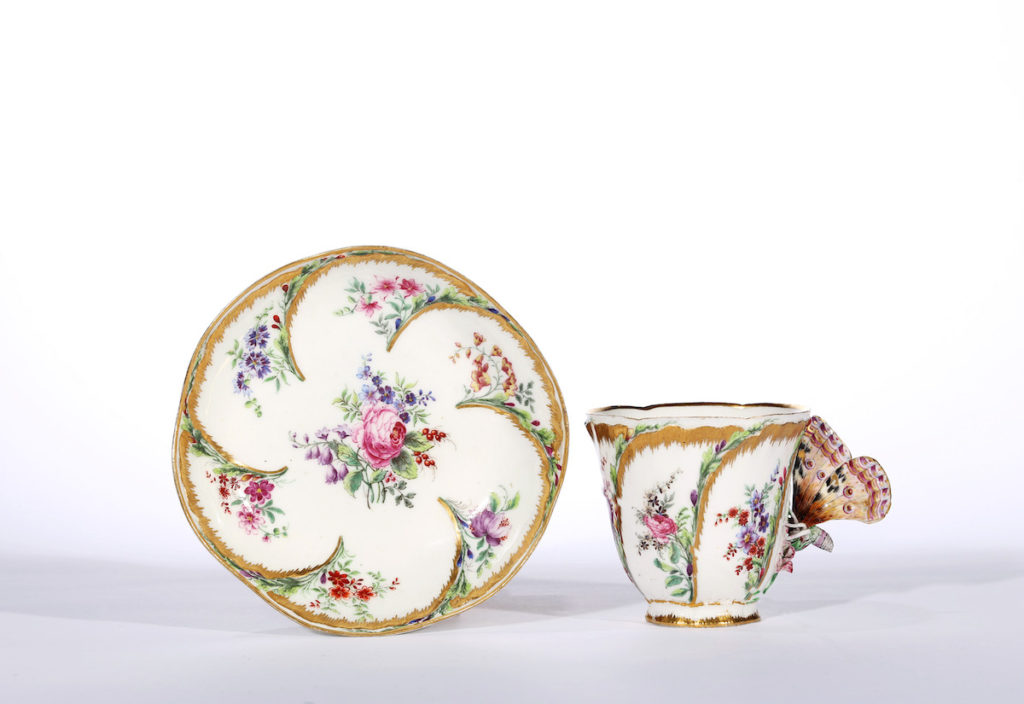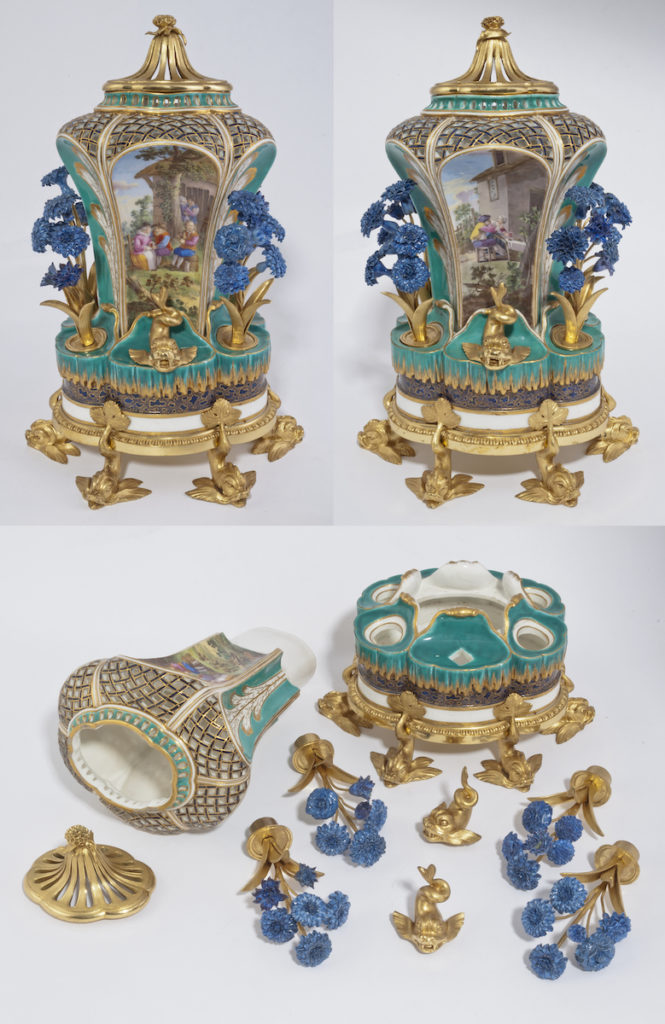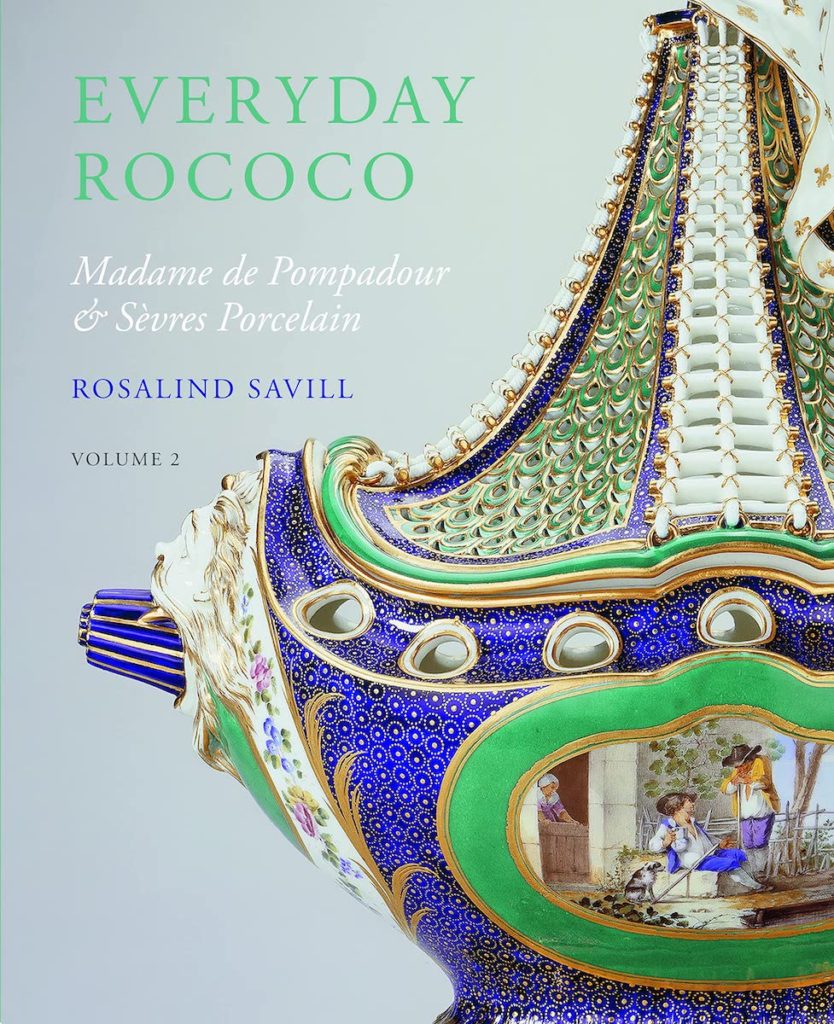Rosalind Savill, Everyday Rococo: Madame De Pompadour and Sèvres Porcelain. 2 vols. Norwich: Unicorn Press, 2021. 1211 pp. $275. ISBN 978-1916495715
Dame Rosalind Savill’s Everyday Rococo: Madame de Pompadour & Sèvres Porcelain is a magnificently produced two-volume study of the early development of the Sèvres Porcelain Factory, from its origins in the Manufacture de Vincennes to the death of madame de Pompadour in 1764. The set consists of 1211 pages in 21 chapters with two appendices and the full apparatus of scholarly documentation. The chronology begins in the year 1745, when the twenty-three-year-old Jeanne-Antoinette Poisson, wife of Charles Guillaume Lenormant d’Étiolles, left her husband and became the recognized mistress of King Louis XV (1715-1774). Thereafter, until her death nearly 20 years later, on April 15, 1764, she was the hostess for the king’s unofficial life in the private apartments at Versailles, in her own apartments in the royal palaces, and in her own private houses.
Jeanne-Antoinette Poisson, ennobled as the marquise de Pompadour in 1745, was a commoner by birth who was endowed with intelligence, physical allure, talent in performance and handcrafts, and a full measure of determination. A well-read amateur, in the best eighteenth-century sense of that term, madame de Pompadour was an artist in her own right and an enthusiastic sponsor of artistic manufactures, most especially the ceramics which could be used so inventively in every aspect of daily life.
Savill has produced a scholarly book that now takes its place as one of the most authoritative sources for students of Vincennes and Sèvres porcelain and perhaps the preeminent such study in English for the period it covers. It is the achievement of a lifetime of research and close study of original works of art. The photography is exquisite and was guided by the author expressly for this publication to visually demonstrate the techniques and details of craftmanship that are discussed in the text.

BOTTOM: Fig. 2. Vincennes, Selection of Flowers, 1747-1755. Soft-paste porcelain. Collection of Adrian Sassoon. Reproduced with permission. Savill, Everyday Rococo, vol. I, fig. 4.13, p. 63.
The book has a simple chronological armature of 21 chapters with an introduction and one chapter each for the years from 1745 to 1764. Savill’s narrative is interspersed with capsule studies of everyday patterns of domestic usage. Tucked into the chapter on the year 1745, for example, is a mini essay on daily routine from Morning awakening (about 9) to Dinner Time (12:30) to “After Dinner” afternoon activities to evening light suppers and table games or special evenings of balls. There is a delightful and learned treatment of the art of porcelain flowers embedded in Chapter 4 (1747), which is accompanied by radiant new photography made especially for Savill’s book (Figs. 1 and 2). It demonstrates how botanically precise the artisans of the eighteenth century were in rendering in three dimensions and in color what the comte de Buffon and other naturalists of the Enlightenment could only illustrate with black and white engraving in their groundbreaking works of classification.

Chapter 9 on the year 1752 has informative digressions on “Eating and Drinking” and on the health craze for fresh milk. Every section has full-page color plates of the most unusual and inventive examples. There are explanations of the distinctive table wares used for dining as opposed to those that were used by one person alone for breakfast or taking medicines or curative restoratives. The Vincennes porcelain cup and saucer of about 1752 with butterfly wings for a handle is one of these rare sets made for one person alone (Fig. 3). Mere contemplation of the porcelain cup would have soothed the ailing health of the person who held it to their lips.
In this book you can learn about everyday practices at the dressing table, hygiene and health, letter writing, the place of pets in the home, gambling as an evening entertainment, useful recreations such as needlepoint and weaving, and interactions with merchants and modistes. Even though madame de Pompadour was precocious in her embrace of advanced practices of hygiene, makeup, fashion, gift-giving, musical and theatrical performance, dining, and entertaining, she anticipated usages that all enlightened women eventually aspired to or adopted in their daily lives.

BOTTOM: Fig. 6. Sèvres, One of the pair of Vases pot-pourri fontaine à dauphin, with painted scenes after David Teniers by Charles-Nicolas Dodin, disassembled, 1760. Porcelain with later gilt-bronze mounts, 34.3 cm. Boughton House, Northamptonshire. By kind permission of the Duke of Buccleuch & Queensberry KBE. Savill, vol. II, Figure 16.13, p. 791. Same as the vase in fig. 5 disassembled, showing all its separately made component elements.
Just reading in isolation Savill’s Chapter 16 on the year 1759, when madame de Pompadour was 37 years old, one is led through the labyrinth of daily life in one of the worst years in French history. France was at a low point in the Seven Years War (1756-1763). The news from the battlefronts in Canada, India, Germany, and the high seas was grim. Louis XV, French foreign minister the duc de Choiseul, and Pompadour all increased their personal expenditures to provide work for the craftspeople (both male and female) who were struggling during the economic downturn of a losing war. Even as the king resorted to the drastic measure of melting his state silver to pay his soldiers, Pompadour was supporting the Sèvres manufactory by buying or ordering for herself some of the most spectacular and expensive confections its artisans were ever to make. 1759-1760 saw the creation of the Sèvres Incense Vase in the Form of a Ship (Pot-pourri à vaisseau) today in the Royal Collection[1] which were paired as a garniture, Savill believes, with the exceptional matching lapis and green pair of Pot-pourri Vase Flower Pots today in Boughton House.[2] Savill provides spectacular photographs of this garniture, which show the Boughton vases assembled (Figs. 4 and 5) and disassembled (Fig. 6). This image alone is worth the purchase price of the entire book for the way it demonstrates the complex number of porcelain and gilt-bronze parts that had to be separately made and assembled to create the magical ensembles that Sèvres was capable of realizing. With this and other examples, one learns succinctly and accurately about the vast variety of Sèvres’s ornamental ceramics that were used in sets as garnitures on mantle pieces or atop cabinets.
Savill plunges us directly into the diplomatic gift-giving activity that Louis XV and his foreign minister, the duc de Choiseul, were pursuing to shore up relationships with wavering allies. While Louis XV gave gifts of state monarch-to-monarch, madame de Pompadour gave personal gifts to individual diplomats or useful friends. Choiseul executed a high-echelon gift exchange with foreign ministers mostly of Gobelins tapestries. Louis XV gave regal gifts made at the royal manufactures of Sèvres, Gobelins, and Savonnerie. Savill provides a deeply textured insight into madame de Pompadour’s personal diplomacy in porcelain, which was complemented by reciprocal gifts she received of lacquer furniture, portrait miniatures, and tokens of esteem. She exchanged unofficial access to the king to representatives of Austria, Denmark, Saxony, Russia, and many other states. Madame de Pompadour, for her part, paid for the gifts she gave with her own money and relied on her own unofficial superintendent of her household purchases, the merchant decorator Lazare Duvaux. Savill’s extensive index and appendices allow a reader to rediscover the essential role played by the private marchand-mercier, who combined the roles of designer, interior decorator, and steward of crating and shipping, installations, and maintenance. Seeing how Pompadour outsourced these services to the realm of entrepreneurial businesses demonstrates that she carried on her own private diplomacy in a language of gifts given and received.
Alongside its value as a history of the rise of a royal porcelain industry in France, this publication is a detailed study of madame de Pompadour’s way of life, of gift-giving, and of entertaining. There are essays on each of Pompadour’s many private houses with tables and charts that explain the floor plans of the houses, the uses of the different rooms, and how they were furnished. Savill has compressed into this book a career’s worth of curatorial research and a personal knowledge of the public and private collections of eighteenth-century ceramics. She has used her retirement from her post as Director of the Wallace Collection to assemble every thread of information about uses, daily practices, display, and the connoisseurship of porcelain craft and production. Everyday Rococo delivers a complete and complex resource that disarmingly and casually scatters nuggets of insight throughout the overarching chronology.
The publication of the book in late 2021 was intended to be accompanied by a two-day scholarly symposium which was delayed six months by the coronavirus pandemic. The book-launch conference, Everyday Rococo: Madame de Pompadour and the Arts, sponsored by The French Porcelain Society and the Wallace Collection, was finally successfully held in July 2022 at the Victoria and Albert Museum to an audience too large for the Wallace Collection auditorium.[3]
Organized by Mia Jackson, Helen Jacobsen, Caroline McCaffrey-Howarth, Nette Megens, Savill, Sophie von der Goltz, John Whitehead, and Félix Zorzo, the conference brought together museum, art trade, and academic researchers to assess the state of understanding of madame de Pompadour’s impact on the arts for the first time since the 2002-2003 major exhibition Madame de Pompadour et les Arts held at Versailles, Munich, and London with the educational programming that accompanied the exhibitions.[4]
It is worth devoting a few paragraphs to the conference, as the contributions by eleven speakers over two days explored aspects of the eighteenth century that complement or offer counterpoint to Savill’s long-anticipated book.
Four of the talks were about porcelain manufacture directly related to madame de Pompadour’s patronage, collecting, and use of porcelain. Whitehead’s paper corrected the myth of an antagonistic relationship between Philibert Orry and madame de Pompadour in the origin story of the Orry brothers’ foundation of the Vincennes factory and the increasing involvement of madame de Pompadour and Louis XV in the eventual transition of ownership from the Vincennes factory to the Royal Manufacture de Sèvres.[5]
In her talk, Savill drew upon her deep knowledge of modern collections in relation to archival records, inventories, and merchants’ registers to drive home the importance of merchants, notably Duvaux, as essential interpreters and orchestrators of their clients’ ambitions for their everyday needs. Savill illustrated examples of both the most utilitarian wares and the most subtle of gifts, linking specific examples to known commissions and owners. Her lecture was a demonstration of how the information in the appendices to her new book can be exploited to correlate purchases of porcelain to precise descriptions that make it possible to match archival records to specific or very similar surviving examples.[6]
Two papers addressed madame de Pompadour’s collecting of non-French porcelain. Joana Mylek gave a guide to madame de Pompadour’s use of Meissen porcelain, while Kristel Smentek provided a compelling visual survey of the types of Chinese and Japanese porcelains that she displayed in gilt bronze mounts consistent with an established French taste.[7] Smentek showed examples with the mounts removed, revealing the ways the bronze mounts were sometimes used to disguise disfiguring damage. This marriage of old porcelain and new-made metalwork also could enhance the way non-identical but similar porcelain sculpture and large vessels could be made to serve as elements in a garniture. Another aspect of madame de Pompadour’s collecting and learning was addressed in Rachel Jacobs’s “Madame de Pompadour’s Library.”
Two French curators addressed the tricky issue of madame de Pompadour’s advocacy of specific styles. While she is commonly associated with rococo, as in the title of Savill’s book, both Alexandre Gady, speaking about architecture, and Bertrand Rondot, citing examples of furniture, stressed that Pompadour was quite flexible about style and was willing to work within the prevailing stylistic parameters of whatever her architect, marchand-mercier, modiste, or manufacturer was advocating as current.[8] The exterior architecture of her personal houses, Gady explained, conformed to the grand goût and even fell within what one might call a French form of classicizing Palladianism. This can be seen in the architectural work done for her by Ange-Jacques Gabriel and Jean Cailleteau fils called Lassurance-the-Younger at the Hermitage at Fontainebleau and at the château de Bellevue. Her furniture was of the prevailing style of the moment, practical in use and fine in execution. By the early 1760s she was comfortable embracing the goût grec in both Sèvres porcelain and in the chests of drawers she ordered for the guest bedrooms at the château de Menars.
Two speakers opened windows on more personal ways that madame de Pompadour represented herself. Aileen Ribeiro, speaking about fashion, addressed the most public facing aspect of her self-fashioning in the very clothing that she wore on her body and in which she permitted her portraitists to represent her.[9] Ribeiro surprised her audience with the assertion that François Boucher had exaggerated the rococo three-dimensionality of the profile of the ruche cascade of ribbons on her gown in her Munich portrait of 1756. So even though listeners learned not to completely trust the depictions of fashion but to expect artistic license, Ribeiro confirmed that madame de Pompadour was a goddess of appearances and firmly understood that her modiste was not a fashion designer but only a purveyor of decorations for dresses that she herself “curated.” She was firmly in command of her self-presentation and chose personally the flowers, jewelry, makeup, and gowns or theatrical costumes in which she would be portrayed, even if she might have left it to an artist to provide or invent a piece of furniture as a stage prop. Ribeiro insisted that Boucher offered a better likeness of a flattering dress than he did of a face and so enhanced her status as a fashion icon. Ribeiro’s observation justifies madame de Pompadour’s complaint to her brother in a letter of April 26, 1750, saying of a copy of a Boucher portrait of her: “It very much resembles the original [version] of my portrait by Boucher, but very little to me, however quite agreeable.”[10]
Mia Jackson’s contribution provided an insight into madame de Pompadour’s private world through her commissions of portraits of the birds and dogs she kept as pets.[11] Madame de Pompadour had a private aviary where she kept parrots, cockatoos, pheasants, finches, pigeons, chickens, and monkeys, all of which were portrayed by painters in images that were incorporated into porcelain decorations for boxes and for larger vessels. Her four dogs also appeared in many playful combinations in the art she lived with.
Two papers addressed madame de Pompadour as an artist amateur. Susan Wager spoke about her etchings after Jacques Guay’s hardstone gems, which were themselves personal commissions from madame de Pompadour to Guay.[12] Wager addressed the almost archaeological way she used her etchings as an impersonal catalog of a small part of her collection, treating them as though they were already prized ancient works. In this way, madame de Pompadour’s illustrations were in the spirit of Mariette or Caylus as amateurs in the eighteenth-century sense of learned independent scholar-artists. Wager described how the aloof, impersonal character of madame de Pompadour’s prints—even when rendering objects she owned and gave as gifts—disappointed nineteenth-century writers, notably the Goncourt brothers, who wanted to discover personally intimate and revealing passions in her art. The unappreciated significance is that the dispassionate and scientific recording by madame de Pompadour was her demonstration that she was an amateur printmaker and publisher precisely in the vein of her male contemporaries. She very deftly offered in her prints a selected fraction of the gifts she had shared with Louis XV without revealing anything intimate or personal whatsoever.
In the last communication of the conference, this reviewer gave a paper attempting to discern madame de Pompadour’s personal language and hierarchy of gift-giving.[13] In this construction, Pompadour’s extensive gift-giving was a calibrated stratified system which permitted her to give or receive personally unrevealing gifts with people she might never have met, but which permitted her to escalate the gift exchange to ever greater degrees of personal revelation. She did, for example, exchange Savonnerie carpets with Count Moltke of Denmark for a reciprocal gift of Frederiksborg mares to draw her coach. Such an exchange was a form of friendly barter that revealed no personal knowledge. For people to whom she wished to demonstrate a greater degree of fidelity she gave gifts of her own hand-made prints. While it was more prestigious to receive an original work of art made by the giver, it was still safe for her to give these prints to French courtiers who might prove to be unreliable friends because of their relative neutrality about her personal life.
At the apex of Pompadour’s gifts were portraits of herself and above all self-portrait miniatures. A gift of a self-portrait on the very smallest scale was more precious to an appreciative recipient than an expensive manufactured object and was given only to her most cherished and trusted family and inner circle. These most sincere expressions of intimacy were never seen by outsiders during her lifetime.
Alden R. Gordon is Paul E. Raether Distinguished Professor of Fine Arts at Trinity College in Hartford, CT
[1] A partial image of the Sèvres pot-pourri in the form of a vessel with a mast from the Royal Collection appears in the dust jacket image of Savill, vol. 2, reproduced above.
[2] The Boughton pair of Sèvres flower pots have reserves painted by the Sèvres painter Charles-Nicolas Dodin after canvases by David Teniers.
[3] The French Porcelain Society, “Everyday Rococo: Madame de Pompadour and the Arts Conference,” Victoria and Albert Museum, London, July 1-2, 2022. Links to the recordings of the symposium are available to ticket holders. For those who didn’t attend the symposium live, either in person or online, there is the possibility of purchasing access to the recordings through this link: https://www.thefrenchporcelainsociety.com/product/symposium-everyday-rococo-madame-de-pompadour-arts/. For any questions, please contact newsletterfps@gmail.com.
[4] Xavier Salmon, Madame de Pompadour et les arts (Paris, Réunion des Musées Nationaux, 2002).
[5] John Whitehead, “The crisis of 1745 – new thoughts on Madame de Pompadour, the Orry brothers and the Vincennes porcelain factory,” Everyday Rococo Conference.
[6] Notably Savill’s Appendix 1, Part 1, “Madame de Pompadour’s Purchases of Vincennes/Sèvres Porcelain 1747-1763,” and Part 2, “Purchases of Vincennes/Sèvres from Lazare Duvaux,” vol. 2.
[7] Joana Mylek, “Madame de Pompadour’s Collection of Meissen Porcelain,” Everyday Rococo Conference; Kristel Smentek, “Asia at Home: Madame de Pompadour’s Mounted Chinese Porcelain,” Everyday Rococo Conference.
[8] Alexandre Gady, “Madame de Pompadour as a Patron of Architecture: Some Reflections,” Everyday Rococo Conference; Bertrand Rondot, “A Rococo Rupture: Madame de Pompadour’s Taste in Furniture,” Everyday Rococo Conference.
[9] Aileen Ribeiro, “Madame de Pompadour and the Goddess of Appearances,” Everyday Rococo Conference.
[10] Morgan Library and Museum, New York, Manuscript M 2628 (6), Jeanne-Antoinette Poisson, Madame de Pompadour to Abel-Poisson de Vandières, April 26, 1750, published in Auguste Poulet-Malassis, Correspondance de Mme de Pompadour avec son père, M. Poisson, et son frère, M. de Vandières (Paris, J. Baur, 1878), Letter IX, 52-53. “… Je vous envoye enfin la copie de mon portrait de Boucher; elle ressemble beaucoup à l’original, peu à moi, cependant assés agréable.”
[11] Mia Jackson, “Pampered and Adored: Madame de Pompadour’s Pets,” Everyday Rococo Conference.
[12] Susan Wager, “Pompadour sculpsit: Gems, Prints, and Authorship,” Everyday Rococo Conference.
[13] Alden Gordon, “The Language of Gifts: Madame de Pompadour’s Hierarchy of Giving and Receiving,” Everyday Rococo Conference.
Cite this note as: Alden R. Gordon, “Madame de Pompadour and Sèvres Porcelain: A Review,” Journal18 (December 2022), https://www.journal18.org/6631.
License: CC BY-NC
Journal18 is published under a Creative Commons CC BY-NC International 4.0 license. Use of any content published in Journal18 must be for non-commercial purposes and appropriate credit must be given to the author of the content. Details for appropriate citation appear above.

